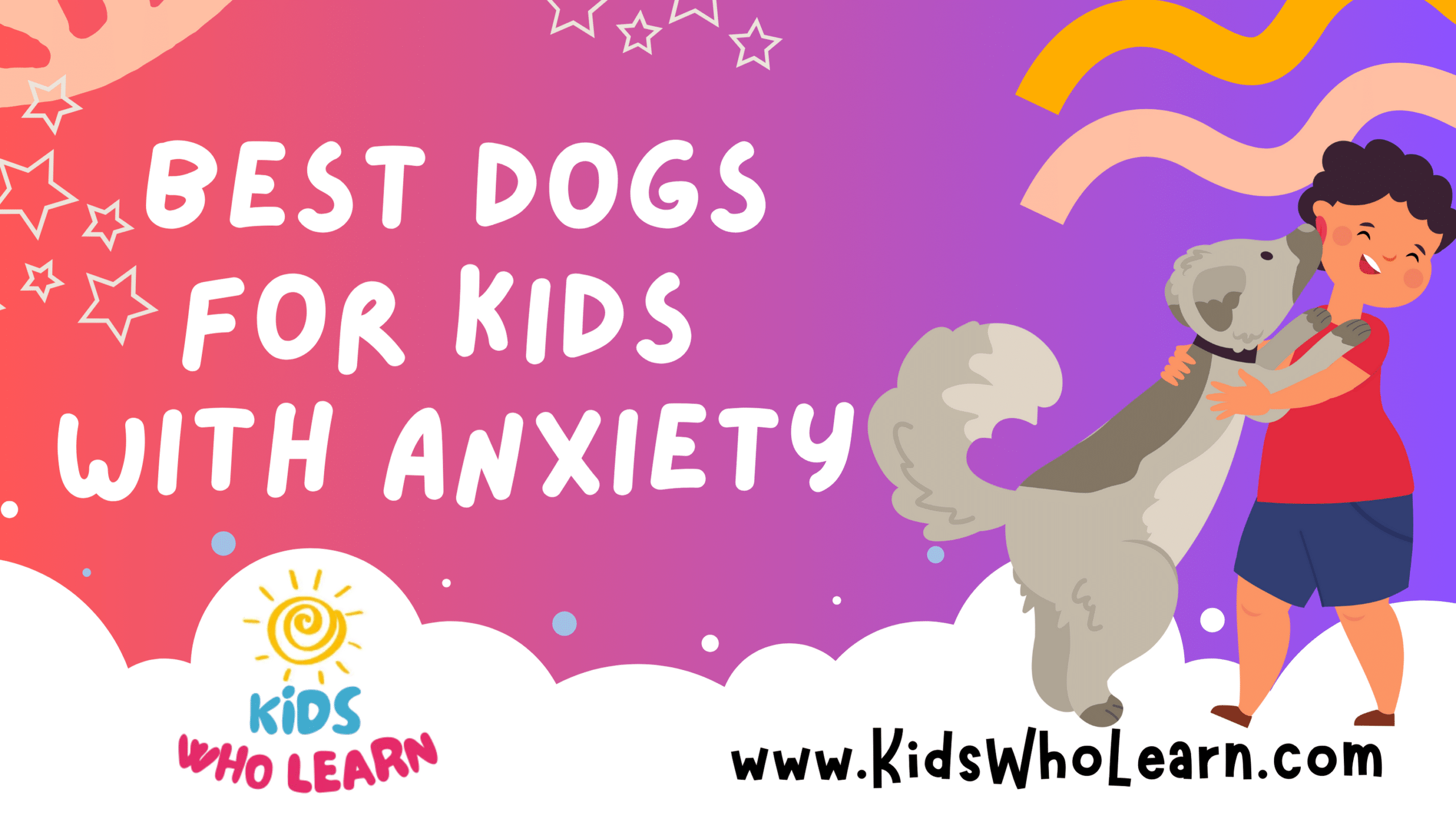Selecting the best dog for a child with anxiety can be a transformative decision, offering comfort, companionship, and a calming presence. With an increase in awareness about mental health, many families are recognizing the therapeutic benefits that dogs can provide to children suffering from anxiety. The bond between a child and a dog can foster a sense of security, reducing feelings of anxiety and stress.
When choosing a dog for a child with anxiety, it’s important to look for breeds known for their gentle nature, patience, and loyalty. Certain breeds are naturally more suited to be calming companions due to their temperament, size, and energy levels. These dogs can become a source of constant support, teaching kids responsibility and providing a distraction from anxious thoughts through play and interaction.
Introducing a dog to a family with an anxious child requires careful consideration and planning. Ensuring that the dog’s needs are met and that the child understands how to interact with their new pet will help create a harmonious living situation. Over time, the right dog may not only help in alleviating the child’s anxiety but also bring joy and cohesion to the entire family.
Key Takeaways
- A dog can provide therapeutic benefits to children with anxiety.
- Choose breeds with a gentle demeanor and patience for anxious kids.
- Thoughtful integration of the dog into the family is crucial for success.
Understanding Anxiety in Children
Anxiety in children can present in various forms, and recognizing these symptoms is crucial. Equally important is understanding how canine companions can offer comfort and support, aiding in the improvement of a child’s mental health.
Symptoms of Anxiety
When your child is experiencing anxiety, you might observe physical and emotional signs including:
- Physical Symptoms:
- Increased heart rate
- Elevated blood pressure
- Emotional Symptoms:
- Persistent worry
- Sudden changes in behavior or mood
These indicators are your cues to take supportive action for their mental health.
Benefits of Canine Companions
Dogs can provide:
- Comfort: A warm presence that eases feelings of distress.
- Affection: Unconditional love that doesn’t judge or criticize.
Through interactions like petting, their unconditional love can lower cortisol levels and boost oxytocin, which is often referred to as the ‘love hormone.’
Role of Pets in Improving Mental Health
Canine companions act as emotional support animals, offering:
- Emotional Stability: They provide a comforting routine.
- Physiological Benefits:
- Reduced Anxiety: Engaging with a pet can lead to a decrease in your child’s anxiety symptoms.
- Lowered Stress Indicators: Studies have shown that petting a dog can reduce heart rate and blood pressure, further easing anxiety.
Characteristics of Dog Breeds for Kids with Anxiety
When choosing a dog for a child with anxiety, it’s crucial that you consider breeds known for their calm temperament, manageable energy levels, and ease of training. These characteristics can create a nurturing environment for your child.
Temperament and Behavior
- Calm: You’ll want a dog with a calm demeanor that can help lower cortisol levels, rather than exacerbate anxiety.
- Examples: Labrador Retrievers, Golden Retrievers, Cavalier King Charles Spaniels
- Gentle and Affectionate: A dog that is gentle and shows affection will provide comfort.
- Examples: Beagles, Pugs, Newfoundland Dogs
- Friendly: An innately friendly breed will interact well with children and other family members.
- Examples: Beagles, Boxers, Irish Setters
Size and Energy Levels
- Size: Smaller to medium-sized dogs are often ideal, as their size can be less intimidating and easier to manage.
- Good fit for kids: Cocker Spaniels, Beagles, Bulldogs
- Energy Levels: Moderate energy levels are suitable as they require exercise, which can be therapeutic, but are not overwhelmingly hyperactive.
- Moderate energy breeds: Shetland Sheepdogs, Pembroke Welsh Corgis, Boston Terriers
Trainability and Intelligence
- Trainability: Dogs that are easier to train can become reliable companions quicker and can also be trained for therapy or service roles.
- Smart and trainable breeds: Poodles, Labradors, German Shepherds
- Intelligence: Intelligent dogs can be sensitive to their owner’s needs and are able to adapt their behavior accordingly.
- Perceptive breeds: Border Collies, Standard Poodles, Australian Shepherds
Recommended Dog Breeds for Children with Anxiety
Choosing the right dog can make a significant difference for a child with anxiety. The breeds listed below are known for their temperament and ability to provide comfort and support.
Golden Retrievers and Labrador Retrievers
Golden Retrievers and Labrador Retrievers are exceptional companions for children. Their friendly nature and intuitive sensitivity to human emotions make them ideal for providing emotional support and reducing anxiety.
- Golden Retriever: Known for its patient and gentle behavior.
- Labrador Retriever: Highly trainable and known for its steady temperament.
Cavalier King Charles Spaniel and Yorkshire Terrier
The Cavalier King Charles Spaniel and Yorkshire Terrier are smaller breeds that offer big-hearted companionship. They are adaptable to various living situations and are great at providing affection and attention.
- Cavalier King Charles Spaniel: Its calm and loving demeanor helps soothe anxious children.
- Yorkshire Terrier: Small but protective, offering a sense of security while being a portable size for comfort on the go.
Calm Breeds for Less Active Lifestyles
For families looking for less active dogs, consider breeds like the Pug and French Bulldog. Their low energy levels and affectionate nature make them great for comforting children without the need for vigorous exercise.
- Pug: Charming and sociable, with a comforting presence.
- French Bulldog: Requires minimal exercise and is content with being a lap dog.
Small Dogs: Companionship and Comfort
Small dogs like Poodles bridge the gap between active and sedentary lifestyles. They are intelligent and easily trained, providing both companionship and a sense of security.
- Poodles: Available in various sizes and known for their smart and hypoallergenic coats.
Large Dogs: Protection and Presence
Gentle giants such as Great Danes and Bernese Mountain Dogs can be imposing in size but are renowned for their protective nature and serene disposition.
- Great Danes: Despite their size, they are gentle and often referred to as ‘nanny dogs’ for children.
- Bernese Mountain Dog: Their large stature offers a feeling of security and they are known to be very affectionate with family members.
Breeds for Deep Pressure Therapy
Dogs that can provide deep pressure therapy can be particularly soothing. This technique involves applying gentle pressure to the body, which can release calming hormones.
- Labrador Retriever: Often trained as therapy dogs, capable of providing comforting pressure.
- Golden Retriever: Size and trainability make them suitable for deep pressure therapy work under the guidance of a trainer.
When choosing a breed, it’s essential to consider your child’s specific needs and lifestyle. Consulting with a professional trainer may help to ensure a perfect match.
Integrating a Dog into the Family
When you bring a dog into your home, it’s essential to prepare your environment, nurture the bond with your new pet, and understand the specific training needs to support a child with anxiety.
Preparation and Responsibilities
Before your dog arrives, you should create a welcoming space within your home that aligns with your family’s lifestyle. Ensure you have all necessary supplies such as a bed, food, and toys. Assign age-appropriate responsibilities to your children to foster a sense of involvement:
- Pet Care Tasks:
- Feeding: Twice daily (morning and evening)
- Walking: 30 minutes of exercise, twice daily
- Playtime: At least once a day to encourage social interaction
Encourage your children to take part in these activities to create a routine that merges play and responsibility. This approach helps blend care for the dog with their daily activities and promotes loving care and patience.
Bonding with the Dog
Bonding with your family dog is crucial for a harmonious relationship, especially when the dog is meant to support a child with anxiety. Here are a few steps to encourage a strong connection:
- Spend quality time with your dog daily.
- Offer treats gently to build trust.
- Engage in calm, soothing play to avoid overstimulation.
These interactions should be shared amongst all family members to ensure the dog views everyone as part of its pack and to support the child’s ability to bond with the new family member.
Training for Anxiety Support
Training your dog to assist a child with anxiety involves more than basic obedience; it involves specialized support behaviors. Key training goals include:
- Recognition: Training your dog to recognize signs of anxiety in your child.
- Intervention: Teaching consistent responses, such as cuddling or laying beside your child during anxious episodes.
- Distraction: Using play as a method to distract your child from anxiety-provoking situations.
Regular, consistent training sessions led by a professional can help reinforce these behaviors. Patience and clear, neutral instructions are vital to assist the dog in understanding its role within the family dynamics.
Caring for Your Dog
Ensuring your dog remains healthy and happy is vital, particularly when they play a role in the wellbeing of children with anxiety. Proper veterinary care, regular exercise, and thorough socialization are foundational to your pet’s quality of life.
Veterinary and Health Care
You must take your dog for regular check-ups to a veterinarian to safeguard their health. Keep up with the following essentials:
- Vaccinations: Maintain an up-to-date vaccination record.
- Parasite Control: Protect against fleas, ticks, and heartworm.
- Dietary Management: Offer balanced meals suited to your dog’s age, size, and activity level.
- Emergency Care: Know where to go for immediate care outside regular hours.
Exercise and Play
Regular exercise and play are crucial not just for physical health but also for mental stimulation. Formulate a plan that covers:
- Daily Exercise: Aim for at least 30 minutes to an hour of activity, such as walking or running.
- Safe Play: Use appropriate toys that encourage interaction without risk of injury.
- Rest Time: Ensure your dog has access to a quiet spot for relaxation and sleep.
Socialization and Travel
A well-socialized dog is usually more comfortable during travel and in social settings. To achieve this, consider the following:
- Social Interactions: Gradually introduce your dog to various people and other dogs in controlled settings.
- Travel Preparations: Familiarize your dog with a crate or carrier to ease the stress of travel.
- Behaviour Training: Consistently reinforce positive behavior with rewards and gentle guidance.
Potential Challenges and Considerations
When selecting a dog for a child with anxiety, it’s important to align your expectations with the realities of owning a pet. Dogs can be a source of comfort, but they come with their own set of needs and behaviors that require understanding and commitment.
Managing Expectations
When you’re considering a dog for your child, it’s essential to set realistic expectations. Not all dogs have a calming effect on every individual, and factors such as a dog’s energy level and temperament can significantly affect the experience. It’s crucial to understand that while a dog may help to alleviate symptoms of anxiety disorders, they are not a cure.
- Energy Levels: Select a dog whose energy level matches your family’s lifestyle.
- High-energy dogs may require more exercise and stimulation, potentially overwhelming a child with anxiety.
- Lower-energy dogs may be more suitable for providing calm companionship.
- Temperament: Look for breeds known for their gentle and patient demeanor, as they’re more likely to be understanding of a child’s needs.
- Avoid breeds that are known to be stubborn or overly shy, as this can create challenges in training and socialization.
Understanding Dog Behaviors
Dogs have a range of behaviors that stem from their breed characteristics and individual personalities. Recognize that some dogs may have a high prey drive, which could be stressful for a sensitive child. Dogs with strong herding instincts might nip at children to corral them, and this is natural for the breed but may not be suitable for a child with anxiety.
- Prey Drive: Choose breeds with a lower prey drive to avoid the chase instinct triggering a child’s anxiety.
- Sensitivity: Sensitive dogs can be more responsive to a child’s emotional state but might also get easily overwhelmed by loud noises or chaotic environments.
Recognizing Responsibility
Owning a dog is a major responsibility, and it’s vital to ensure that your child is ready to take on the commitment with your support. You must be prepared for the demands of training, socialization, and daily care, which are important for the well-being of both the dog and your child.
- Training and Socialization:
- Training helps manage behaviors and fosters a strong bond between the dog and your family.
- Socializing the dog early can prevent the development of fear-based behaviors that might exacerbate a child’s anxiety.
- Daily Care:
- Regular exercise, grooming, and veterinary care are necessary to keep the dog healthy and content.
- Establish routines to help the child understand and participate in caring for the dog, reinforcing a sense of responsibility.
By addressing these considerations, you can make a more informed decision about bringing a dog into a home with a child who experiences anxiety. It’s about finding a balance that benefits both the child and the dog.
Beyond the Home: Therapy and Service Dogs
When considering dogs for children with anxiety, it’s important to recognize that therapy and service dogs offer valuable support beyond the home environment. They play distinct roles and are trained to perform specific tasks that can help mitigate anxiety symptoms.
Service Dogs for Anxiety
Service dogs are trained to perform tasks that assist individuals with disabilities, including those related to anxiety. Your service dog can recognize and interrupt early signs of anxiety or panic attacks by engaging in a trained task like deep pressure therapy. These canines are legally recognized and are allowed to accompany you in most public places under the Americans with Disabilities Act (ADA).
Qualification:
- Individual must have a diagnosed disability
- Dog must be trained to perform tasks directly related to the disability
Benefits:
- Can detect signs of anxiety and provide calming pressure
- Help increase independence and reduce reliance on human caregivers
Therapy Dogs in Public Spaces
Therapy dogs differ from service dogs as they primarily provide comfort and support through their presence. They are often found in settings like schools, hospitals, or airports, where they can help you alleviate stress or anxiety through interaction. These dogs are not granted the same public access rights as service dogs, but they are often welcomed in various public spaces specifically for therapeutic work.
Access Permitted:
- Schools
- Hospitals
- Airports
- Other institutions upon invitation
Interaction:
- Petting
- Hugging
- Playing
Canine-Assisted Interventions
Canine-assisted interventions involve structured activities aimed at improving your psychological well-being. This could involve a therapy animal helping you develop social skills or providing comfort during therapeutic sessions. These interventions often involve a handler and are implemented by mental health professionals as part of a broader therapeutic plan.
Methods:
- Social skills development
- Non-verbal communication enhancement
- Emotional regulation support
Considerations:
- Interventions should be part of an individualized therapeutic plan
- Always involve trained professionals and animals
Frequently Asked Questions
Selecting the right dog for your child with anxiety requires consideration of the breed’s temperament and how it might help with anxiety management.
What are the top breeds of service dogs recommended for managing children’s anxiety and depression?
Labrador Retrievers, Golden Retrievers, and Poodles are highly recommended for children with anxiety and depression, as they are known for their gentle nature and ability to be trained as reliable service dogs.
Which hypoallergenic dog breeds are suited for children with anxiety?
Bichon Frise, Portuguese Water Dog, and Soft-Coated Wheaten Terrier are breeds that are less likely to cause allergies and are known for their friendly disposition, making them suitable companions for children with anxiety.
How can emotional support dogs contribute to alleviating anxiety in children?
Emotional support dogs provide consistent companionship, which can help reduce feelings of anxiety in children by offering comfort, a sense of security, and a calming presence to help manage anxiety symptoms.
What small dog breeds are known to be effective for calming anxiety in kids?
Cavalier King Charles Spaniels, Pugs, and Chihuahuas are small dog breeds that are known for their affectionate nature and can be particularly effective at providing comfort and reducing anxiety in children.
Are there ways to obtain a free service dog for a child suffering from anxiety?
There are various organizations and non-profits that provide service dogs at no cost to qualifying individuals. You can research and apply to these programs, which often require documentation of the child’s need for a service dog.
How do dogs provide comfort during anxiety attacks for both children and adults?
Dogs can sense distress and often respond with calming behaviors like cuddling or placing their head in their owner’s lap. Their presence can help slow down a person’s heart rate and provide a distraction from anxiety triggers.









